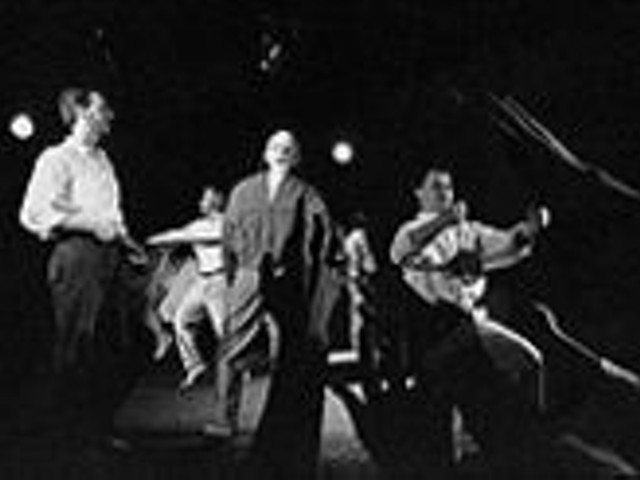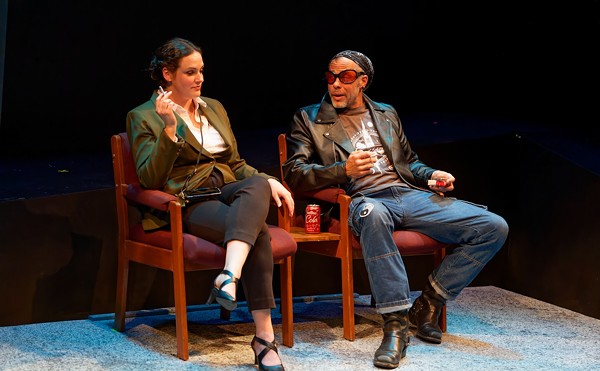If we were to focus a critical eye on the mundane more often, we would see how arbitrarily any world is furnished. Design is so often overlooked, but hell, it's why our doorknobs, dashboards, forks and toilets look the way they do. The cult of design exerts a subtle but universal influence on the way we think about everything. Period.
Charles and Ray Eames are not names that the average Joe recognizes, but make no mistake, for many of the designs we now take for granted they are the couple behind the curtain. St. Louis-born Charles and wife Ray are probably most noted for their stalwart chairs, which occupy classrooms, cafeterias, stadiums and airports everywhere. Their molded-plywood chair, first produced in the mid-'40s, is almost as common as the lightbulb. Their fiberglass chair and leather-and-plywood lounge chair and ottoman are instantly recognizable and will no doubt elicit lots of oh-they-did-thats from visitors to the St. Louis Art Museum's showing of the traveling exhibit The Work of Charles and Ray Eames: A Legacy of Invention.
It is probably largely because Charles hails from our town that we were able to snag this marvel of Eamesian artifacts. Eames was born in 1907 to a father who worked as director of security at Union Station. Charles attended Yeatman High School and worked at the Laclede Steel Mill. He designed a few sets for the Muny and got himself kicked out of Washington University's school of architecture, allegedly for supporting the ideas of Frank Lloyd Wright at a time when Beaux Arts design was practically enforced. In 1935, the young Eames designed the Meyer home in Huntleigh. Pieces from that residence will appear in the show.
Then something happened after World War II. Industry was humming and bold ideas could go a long way in the boomtime. Charles had married a painter, nicknamed Ray, who had her own creative fire, and together the couple was bursting with big plans.
"There was whimsy and optimism after the war, and great expansion," says Art Museum curator of decorative arts and design Cara McCarty. "It was a pivotal moment." The pair wanted to use widely available materials to construct simple, practical, inexpensive domestic and commercial items. What could be more basic than the chair? The Eameses' plywood and fiberglass chairs were spit out of the fac-tory in terrific numbers, but the design that rendered them, says McCarty, was an "organic, crafted approach to mass- produced furniture."
As far as the special exhibits that visit big museums, masks are fascinating, Monet's giant pondscapes will move you and ancient Egypt is mysterious and compelling, but none of these is as sharp to the taste as the Eames exhibit. The study of how these married Benjamin Franklins touched so many facets of the way we live, and the cleverness around every turn, will not fail to interest and enlighten a single viewer.
The show includes plenty of chairs, of course; a giant mold used for fabricating chairs; and plenty of TV monitors and projectors running a good number of the many films the Eameses completed. These include "Blacktop," a 1952 short that divines the beauty in the spreading of soapy water across an asphalt schoolyard. The projector will point down at a white screen mounted on the floor, and museumgoers will be able to walk through the projecting light and onto the blacktop, as it were.
The Eameses were not limited by the medium of furniture, designing a variety of projects for clients; for what they believed would promote the betterment of society; and just for fun. The exhibit includes a model of the "Case Study House" in Southern California that the Eameses designed to demonstrate the ease and speed of working with prefabricated materials and the charm of using mutable elements, such as differently colored wall panels, to suit the moods of the occupants. (The couple actually lived in the house.) A group of local high-school students will construct a sculpture from the Eameses' "House of Cards" deck of colorful slotted cards for 3-D play.
Other toys designed by the couple will be there, as well as napkin diagrams of projects and sales brochures from the Herman Miller company of Zeeland, Mich., still selling the same Eames furniture.
What many consider the couple's greatest achievement, the 10-minute film "Powers of Ten," will be shown continuously in one of the five rooms of the exhibit. This journey in scale from the largest to the smallest glimpses of life in the universe is about the simplicity of adding or removing another zero from our scope, zooming in or out by another power of 10. The amazing thing is that the widest view of our universe, an image of space in its most thrilling vastness, looks an awful lot like the view of subatomic parts afforded by the most powerful microscope in the world. It's all relative.
There is so much more here on the Eameses' Midas touch and the breadth of their da Vinci-style curiosity and experimentation: the film about life in America with seven independent sets of images shown simultaneously on seven screens suspended within one of Buckminster Fuller's geodesic domes at the 1959 Moscow World's Fair; the stools modeled after chess pieces and the dinner table inspired by a surfboard; the film made for IBM to explain the nascent computer to the masses; the storage unit and desk with parts that migrate according to the user's needs; the stacking chairs and collapsible sofas; the effect of their nonlinear thinking on the design studios in their wake.
Charles and Ray Eames are America's design superstars. Looking at their blueprints for a better life reveals just how their creative explosions shaped our style.
The Work of Charles and Ray Eames: A Legacy of Invention is on display at the St. Louis Art Museum Feb. 19-May 14. Cost is $3-$5. Call 721-0072 for information.





